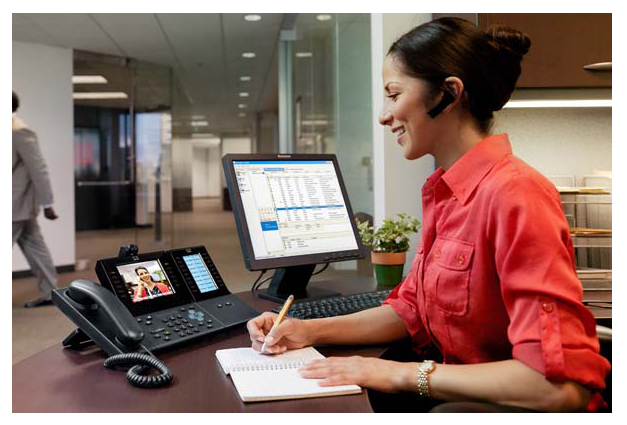
Let's take a hypothetical case: visit the headquarters of a supplier or the competition and discover that on the tables are not the usual phones, like those in your company, but different ones. They have a screen and many other functions and, in addition, they are not connected to the telephone network but by Ethernet. If it has happened recently, then it is possible that your company requires an update urgently to incorporate a VoIP telephony system. We explain why you should do it now, before it's too late.
VoIP telephony against traditional telephony
To situate what VoIP telephony is, it is necessary to understand that the main difference between both systems is the means by which the telephone signal is propagated. In tradicional analogue telephony, which has been with us for more than 100 years, and the RTC digital telephony, which replaced it since the 90s, the signal goes through the telephone cable. Although, in traditional digital telephony some added services are allowed, such as voicemail, caller ID or call waiting, these services today are totally insuficient for a company or, even, for certain individuals.
In VoIP telephony, the call is a transmission of data that is sent as an Internet protocol, such as the http (which manages the web, for example), but which allows you to connect a software installed in a VoIP telephone terminal or a computer, Tablet or Smartphone to conventional phone numbers. The calls are made through the Internet and it is on the Internet where all the services are located. Thus, VoIP telephony in addition to transmitting the call, allows a series of value-added services and advantages over the usual telephony that we will see below.
VoIP telephony is more versatile
If there is something that stands out in VoIP telephony, it it, without a doubt, its versatility. Conventional switchboards require at least a tricky installation: first the switchboard itself must be installed, which is where all the lines will be connected and where the calls will be distributed internally and externally and from where the extra services will be managed - usually few - that they had been hired. Then you have to wire the office and take the telephone cable to each point where you want a terminal If we want to expand the lines, we will have to see if there is space available and, if there is not, buy a new switchboard. Then, it will be necessry to launch cale to all the new lines.
In VoIP telephony, this is much simpler, specially in the case of software PBXs, since you only have to manage it through the program, add and configure the new lines, configure the terminals and point. That is the versatility brought to telephony in the company.
VoIP telephony is cheaper
In traditional telephony, each call follows a cable route from the origin to the destination. The farther this is, the more costs are added to the call. Although today local or even European calls are in many cases included in a flat rate, calls at a greater dustance do not.
In VoIP telephony this is not the case, because calls are made through the Internet and, as data, they travel through the network as an image, a file...Consenquently, calls have much more competitive costs, without forgetting that VoIP telephony can be used everywhere, as long as there is an Internet connection.
VoIP telephony can take it everywhere
Once the system is installed in our company, we can choose to use a desktop VoIP phone from a manufacturer such as Cisco, use a conventional digital phone with an adapter, or install an application on our mobile device or computer, which allow us to continue using the line when we are out of the office, what is called a softphone.
VoIP telephony is in the cloud and, as long as there is a sufficiently powerful Internet connection, we can access the call and all the added value services of our VoIP exchange service. Imagine travelling to Asia and being able to tak with you the telephone number that you usually use at work. Your customers can continue to call you as if you were in Spain and you, you can make calls from Asia without additional charges.
You can add al the value-added services you can imagine
As we have said before, in the 90s, the transition from traditional analog telephony to digital telephony took place, which meant a leap forward: the voicemail, call waiting, multiple call service was integrated... increased the speed of data transmission with the appaearance of ADSL.
But VoIP telephony far exceeds all these services, since the amount of value-added services of VoIP terminals is immense. In addition to the typical: voicemail or call waiting; we can add the synchronization with the CRM of our company, with the calendar, agenda and e-mail of Exchange, iCloud or Google, customize the music on hold, record calls, make video-conference, send data through the terminal...
The amount of services is so high that it only depends on what we need and the authorized technicial who takes the installation and configuration of our VoIP system will prepare the system to be able to use them.
Your company needs a VoIP telephone switchboard
The advantages of the VoIP exchange are so many with respect to traditional telephony, that we do not fit all in this article. The solutions offered to companies range from closed software options and an integrated installation, configuration and maintenance service, such as Cisco VoIP telephony; to open source alternative such as the Asterisk control units. This system can be freely downloaded from the Internet and adapted to the needs of each company. Of course, it must be the company who takes charge of its installation and maintenance.
What are you waiting for? Implement in your company a VoIP telephony solution with which to be able to move forward into the future.


.jpg)
